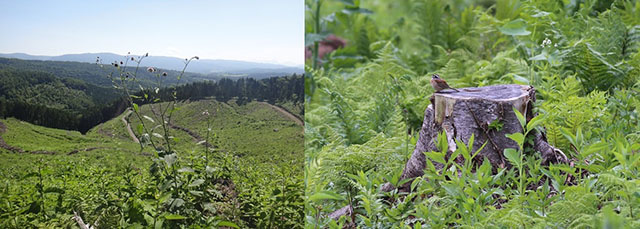Home > International Partnerships > Collaborative Research > Reconciling Biodiversity Conservation and Wood Production at Large Scales
Update:March 22, 2021
Main content starts here.
Reconciling Biodiversity Conservation and Wood Production at Large Scales

1. Partners
Australian National University, Australia
2. Research Period
FY 2017–2019 Grant-in-Aid for Scientific Research (KAKENHI), Fund for the Promotion of Joint International Research
3. Lead Researcher
YAMAURA, Yuichi (Shikoku Research Center)
4. Background
Domestic forestry plays an important role in supporting rural communities and in the conservation of open-habitat biodiversity. However, the environmental and social contexts of domestic forestry have been changing rapidly in recent decades, and we still have only a limited understanding of the relationships between forestry and biodiversity conservation. Therefore, in this study, we examined the role of forestry and human activities in biodiversity conservation over long temporal and broad spatial scales and used the findings to discuss the reconciliation of biodiversity and wood production at large scales.
5. Research Goal
The aims of this study were to examine the roles of forestry and human activities from historical perspectives, to elucidate the roles of secondary natural forests and conifer plantations in biodiversity conservation, and to construct a statistical model to assess biodiversity based on field data.
6. Research Strategy
We analyzed the genomic data of grassland plant species to infer their historical demographic dynamics in Japan. We also analyzed tree plot data collected from throughout Japan and developed a statistical model to spatially evaluate biodiversity conservation in forested landscapes. Finally, we compared a recently developed statistical model for evaluating biological communities with conventional multivariate modeling approaches.
7. Scientific Achievement
The results showed that Japan's cedar plantation forestry is 3- to 4-fold less cost effective than major forestry operations in other countries. When considering the economic efficiency of forestry and the conservation of biodiversity, it is also important to understand benefits other than those related to economic activities in domestic forestry. We also investigated retention forestry in Tasmania, Australia and produced a model to evaluate the biodiversity of forests over a wide area. Furthermore, we clarified the history of domestic grasslands using a genetic approach and developed a new analytical model to clarify the relationship between the biological community and the environment.
8. Applications
By using a wide-area evaluation model of biodiversity and referring to overseas cases to develop an understanding of the history of grasslands, the environmental benefits of the domestic forestry will be enhanced.
9. Publications
Yamaura Y, Narita A, Kusumoto Y, Nagano AJ, Tezuka A, Okamoto T, Takahara H, Nakamura F, Isagi Y, Lindenamyer D. 2019. Genomic reconstruction of 100 000-year grassland history in a forested country: population dynamics of specialist forbs. Biology Letters 15: 20180577.
Yamaura Y, Lindenmayer D, Yamada Y, Gong H, Matsuura T, Mitsuda Y, Masaki T. 2019. A spatially-explicit empirical model for assessing conservation values of conifer plantations. Forest Ecology and Management 444: 393-404.
Yamaura Y, Blanchet FG, Higa M. 2019. Analyzing community structure subject to incomplete sampling: hierarchical community model vs canonical ordinations. Ecology 100(8): e02759.
Yamaura Y, Lindenmayer D, Yamada Y, Gong H, Matsuura, T, Mitsuda Y, Masaki T. 2020. A spatially explicit empirical model of structural development processes in natural forests based on climate and topography. Conservation Biology 34: 194-206.
Copyright © Forest Research and Management Organization. All rights reserved.
